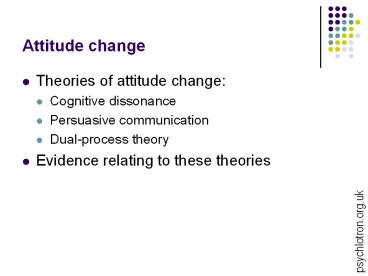Attitude change - PowerPoint PPT Presentation
Title: Attitude change
1
Attitude change
- Theories of attitude change
- Cognitive dissonance
- Persuasive communication
- Dual-process theory
- Evidence relating to these theories
psychlotron.org.uk
2
Consistency principle
Affect
Behaviour
Cognition
psychlotron.org.uk
3
Cognitive dissonance
- Based on the consistency principle
- Dissonance disagreement
- Attitude change occurs when a person has a need
to reduce the dissonance between - Different aspects of same attitude
- Different attitudes
- Attitude behaviour
psychlotron.org.uk
4
Cognitive dissonance
Affect
Affect
Affect
Affect
Behaviour
Behaviour
Behaviour
Behaviour
Dissonance within attitude
Dissonance within attitude
Dissonance within attitude
Cognition
Cognition
Cognition
Cognition
psychlotron.org.uk
5
Cognitive dissonance
I enjoy cigars
Smoking kills people
I smoke
How could Sigmund reduce his cognitive dissonance?
psychlotron.org.uk
6
Cognitive dissonance
- Festinger Carlsmith (1959)
- PPs spent some time doing a tedious task were
then offered either 1 or 20 to tell another PP
it was interesting enjoyable - PPs were later asked to rate how enjoyable the
task had been - How do you think the ratings might differ between
the 1 and 20 conditions?
psychlotron.org.uk
7
Cognitive dissonance
How enjoyable?
psychlotron.org.uk
Control (task only)
1 payment
20 payment
8
Persuasive communication
- The idea that attitude change is brought about by
conveying information. - Success depends on 3 factors
- Source of message
- Content of message
- Nature of target
psychlotron.org.uk
9
Persuasive communication
- Source
- Expert
- Trustworthy
- Credible
- Attractive
- NB sleeper effects nature of the source
matters less after a delay
psychlotron.org.uk
10
Cognitive dissonance
high credibility
low credibility
Attitude change
psychlotron.org.uk
Immediate
4 weeks later
Hovland Weiss (1952)
11
Persuasive communication
- Content
- Fear anxiety
- Not enough or too much and people will ignore the
message - One or two sided argument
- One sided if target is already leaning towards
the sources position - Two sided if the target is intelligent
psychlotron.org.uk
12
Persuasive communication
- Target
- Intelligence
- Age, gender
- Strength of existing views
psychlotron.org.uk
13
Dual process theory
- The likelihood of attitude change is determined
by how the target processes the message - Superficial (peripheral) processing
- Systematic (central) processing
- Which route is taken depends on the relevance
of the message to the target
psychlotron.org.uk
14
Dual process theory
High relevance
Central route
Thorough processing
Sound, logical arguments required
Message
Low relevance
Peripheral route
Superficial processing
The elaboration-likelihood model (Petty et al,
1994)
15
Dual process theory
- Petty et al (1981)
- Student attitudes towards taking an additional
examination - Two IVs
- Level of involvement
- Strength of arguments
psychlotron.org.uk
16
Dual process theory
Level of involvement High Low
Strength of argument Weak Strong
Petty et al (1981)
17
Resistance to change
- Reactance
- Forewarning
- Selective avoidance
psychlotron.org.uk































